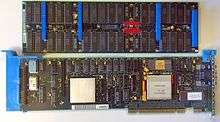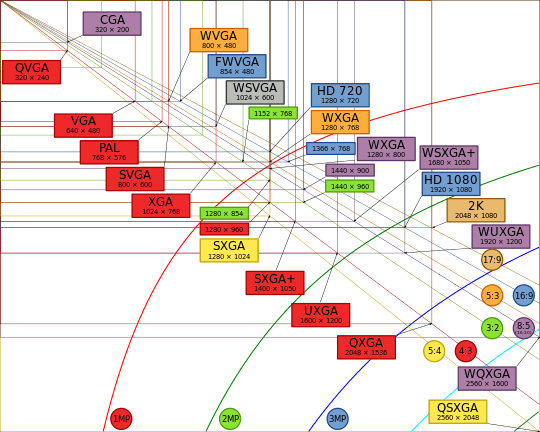IBM 8514
 | |
| Release date | 1987 |
|---|---|
| Cards | |
| Entry-level | IBM Image Adapter/A |
| History | |
| Predecessor | VGA |
| Successor | XGA |
IBM 8514 is an IBM graphics computer display standard supporting a display resolution of 1024x768 pixels with 256 colors at 43.5 Hz (interlaced; 87 fields per second), or 640x480 at 60 Hz (non-interlaced).[1] 8514 usually refers to the display controller hardware (such as the 8514/A display adapter.) However, IBM sold the companion CRT monitor (for use with the 8514/A) which carries the same designation, 8514.
8514 used a standardised programming interface called the "Adapter Interface" or AI. This interface is also used by XGA, IBM Image Adapter/A, and clones of the 8514/A and XGA such as the ATI Technologies Mach 32 and IIT AGX. The interface allows computer software to offload common 2D-drawing operations (line-draw, color-fill, and block copies via a blitter) onto the 8514 hardware. This freed the host CPU for other tasks, and greatly improved the speed of redrawing a graphics visual (such as a pie-chart or CAD-illustration).
History
8514 was introduced with the IBM Personal System/2 computers in April 1987. It was an optional upgrade to the Micro Channel architecture based PS/2's Video Graphics Array (VGA), and was delivered within three months of PS/2's introduction.
Although not the first PC video card to support hardware acceleration, IBM's 8514 is often credited as the first PC mass-market fixed-function accelerator. Up until the 8514's introduction, PC graphics acceleration was relegated to expensive workstation-class, graphics coprocessor boards. Coprocessor boards (such as the TARGA Truevision series) were designed around special CPU or digital signal processor chips which were programmable. Fixed-function accelerators, such as the 8514, sacrificed programmability for better cost/performance ratio.
Later compatible 8514 boards were based on the Texas Instruments TMS34010 chip.
Even though the 8514 was never a best-seller, the product created a market for fixed-function PC graphics accelerators which grew exponentially in the early 1990s.
The ATI Mach 8 and Mach 32 chips were popular clones, and several companies (notably S3) designed graphics accelerator chips which were not register compatible but were conceptually very similar to the 8514/A. 8514 was superseded by IBM XGA.
Software support
Software that supported this graphic standard:[2]
- OS/2
- Windows 2.1
- Windows 3.x
- XFree86 2.1.1
- Autocad 10
- QuikMenu
Clone hardware
Third-party graphics suppliers did not clone IBM's 8514/A as extensively as the VGA. This may be due to the 8514/A being a GPU, not just a graphics array (CRTC) like the VGA.
IBM’s 8514/A boards were not cheap; the 8514 initially sold for $1290 for the adapter and $270 for the 512KB memory expansion. The 8514/A market was severely limited by the fact that IBM’s boards were made only for MCA systems at a time when ISA systems were the most common.
In the late 1980s, several companies cloned the 8514/A often for the ISA bus. Notable among those was Western Digital Imaging’s PWGA-1 (also known as the WD9500 chip set), the Chips & Technologies 82C480, and ATI’s Mach 8 and later Mach 32 chips. In one way or another, the clones were all better than the original with more speed, enhanced drawing functionality and overall improved video mode selections. Clone support for non-interlaced modes at resolutions like 800×600 and 1280×1024 was typical, and all clones had longer command queues for increased performance.
Notable clone adapter cards
- ATI Technologies: the Mach8, Mach32,[1] Graphics Vantage and 8514/Ultra
- Chips & Technologies: F82C480 B EIZO - AA40 and F82C481 Miro Magic Plus
- Matrox: MG-108
- Paradise: Plus-A, Renaissance Rendition II
- Desktop Computing: AGA 1024
- NEC: Multisync Graphics Engine
- IIT AGX and Tseng ET4000 are also referenced as being IBM 8514 compatible.[2][3][4]
Output capabilities
The 8514 offered:
- 640×480 in 256 colors out of 262,144 (18 bit)
- 1024×768 in 256 colors out of 262,144 (18 bit)
- 640×480 text mode with 80×34 characters
- 1024×768 text mode with 85×38 characters
- 1024×768 text mode with 146×51 characters
Latter clone board offered additional resolutions:
- 800×600 with 16-bit and 24-bit color depths
- 1280×1024 with 16-bit and 24-bit color depths
See also
References
- 1 2 "The 8514/A Graphics Accelerator". OS/2 Museum. 2013-05-09. Retrieved 2014-06-19.
- 1 2 "IBM PS/2: 8514/A Graphics Standard". Theodor.lauppert.ws. Archived from the original on 2014-07-14. Retrieved 2014-06-19.
- ↑ InfoWorld - Google Livros. 1990-07-16. Retrieved 2014-06-19.
- ↑ "Archived copy". Archived from the original on 2014-06-29. Retrieved 2014-06-28.
Further reading
- Richter, Jake; Smith, Bud (April 1990). Graphics Programming for the 8514/A: The New PC Graphics Standard. M & T Books. ISBN 1-55851-086-9.
- Sanchez, Julio; Canton, Maria P. (February 26, 2003). The PC Graphics Handbook. CRC. ISBN 0-8493-1678-2.
- Guide to the IBM 8514a
- 8514 Hardware
This article is based on material taken from the Free On-line Dictionary of Computing prior to 1 November 2008 and incorporated under the "relicensing" terms of the GFDL, version 1.3 or later.
